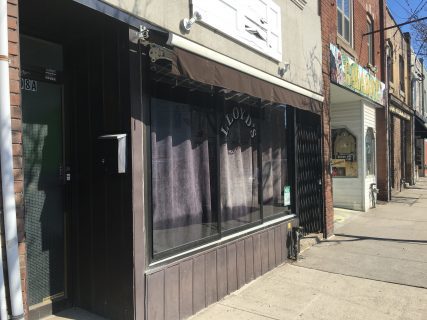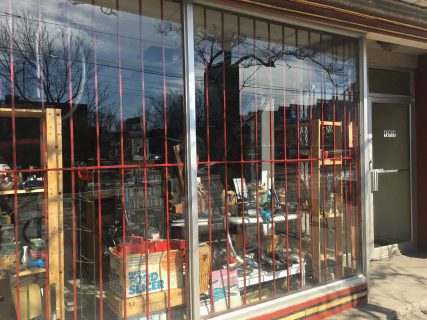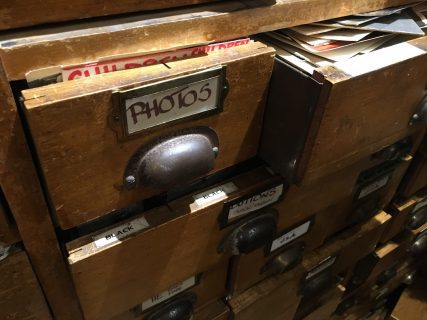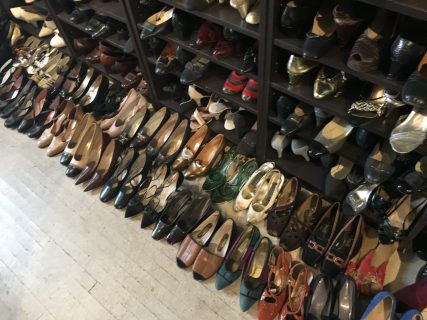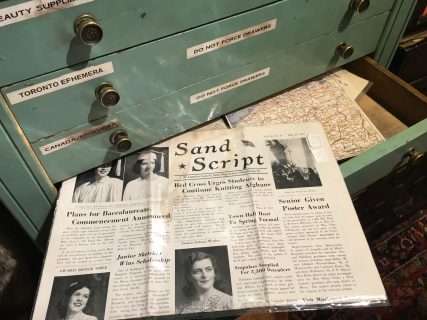[vc_row][vc_column][vc_column_text]
By Severina Chu
[/vc_column_text][/vc_column][/vc_row][vc_row][vc_column][vc_column_text]
Each item in Gadabout Vintage carries a unique journey, whether it’s how it gets to the store or where it ends up. Victoria Dinnick’s eyes sparkle and her voice becomes a bit higher as she talks about some of her favourites among the journeys taken by pieces of inventory in her shop. She recounts the time a girl unexpectedly found a picture of her great-grandmother while rummaging through one of the store’s many drawers of photos. “She was really freaked out and I said, ‘I didn’t go in your house, I promise! She just came in with her stuff!”
[/vc_column_text][vc_single_image image=”2623″ img_size=”large” add_caption=”yes” alignment=”center”][vc_column_text]
On the other side of transactions, there are A-listers who have whisked items away. Among them is director Guillermo del Toro, who personally visits Gadabout, a vintage store on Queen Street East. “He likes the store and comes in to shop with his daughter and his family,” Dinnick says casually about del Toro. He enlisted her help when working on his Oscar-winning film The Shape of Water. “You know the egg timer in the scene where she’s in the bathroom masturbating in the bathtub? That egg timer came from here,” she says proudly.
Other items in the shop have been sold for appearances on shows including Orphan Black and Murdoch Mysteries, with one sold to a supplier of the Harry Potter franchise, according to Dinnick.
[/vc_column_text][/vc_column][/vc_row][vc_row][vc_column][vc_column_text]
Gadabout has items from the late 1800s to the 1970s, many of which Dinnick says are given to the store by people living in the Leslieville neighbourhood where the store is located. With growing gentrification in Leslieville, stores like Gadabout are archiving the community’s history.
[/vc_column_text][vc_column_text]
With the influx of new businesses, Leslieville has seen change over the year. The corner of Jones and Queen streets is one place where change is most evident, with the now famous Leslieville mural welcoming people into the neighbourhood.
[/vc_column_text][vc_column_text]
Walking into Gadabout, the sheer number of items filling the space is almost overwhelming. Toys, books, and other knickknacks fill each cubby to the brim, and the racks of clothes in the center of the store make for cramped quarters. Despite the slew of items, a closer look shows that each cubby is carefully labeled. It’s no surprise that “organized chaos” is how the employee working there describes it.
[/vc_column_text][/vc_column][/vc_row][vc_row][vc_column][vc_column_text]
There’s a faint murmur of a French radio station throughout the store, though sometimes it’s muffled by the creaking of the floorboards as customers pace around. It’s a clear sign of the age of the building – a stark contrast to the many newer, more modern buildings popping up down the street. Despite the building’s wear, each item in the store is meticulously taken care of; old newspaper clippings and book pages are brittle to the touch, yet there are little to no damage or tears.
[/vc_column_text][/vc_column][/vc_row][vc_row][vc_column width=”2/3″][vc_column_text]
Dinnick opened Gadabout 20 years ago after working multiple jobs and selling vintage items at various markets. “The idea of having a store never left me,” she says, adding that her interest in this business was inspired by her great-grandfather’s own store, and influenced by a love of vintage dating back to her youth that she couldn’t shake.
Since the late 1970s, she has worn clothes from the decade before rather than clothes off the rack, and that love for vintage clothing is evident in the store’s collection. The second floor boasts everything from formal tweed coats to colourful skirts. Mannequins model various outfits, and Dinnick singles one out with an eager gesture.
[/vc_column_text][/vc_column][vc_column width=”1/3″][vc_single_image image=”4277″ img_size=”medium” add_caption=”yes” alignment=”right”][/vc_column][/vc_row][vc_row][vc_column width=”1/4″][vc_single_image image=”4264″ img_size=”medium” add_caption=”yes”][/vc_column][vc_column width=”3/4″][vc_column_text]
Tucked in the corner of the room, the mannequin is dressed in a black top filled with red and yellow abstract shapes, paired with a jacket and pants that are a matching vibrant red. Dinnick pulls out her phone and shows me a picture of an old cover of Vogue Magazine she was sent. On the cover, a brunette model is dressed in the exact outfit in front of us.
Not all of her inventory is Vogue couture or Hollywood material. Some of it comes from house calls to people looking to downsize their houses. She also gets referrals as she often buys items others don’t want. “I buy things that other people wouldn’t buy, like old kitchen supplies and pharmaceuticals,” she said. Dinnick always keeps an eye out for props that could be destined for the silver screen. “We buy all the different [trinkets] that a movie might need to set the stage so that people will know immediately what the time period is that the movie is set in.”
[/vc_column_text][/vc_column][/vc_row][vc_row][vc_column][vc_column_text]
The store’s items and customers aren’t the only things with stories to tell. With Dinnick arriving in Leslieville in 1987, she’s witnessed the area change and become the bustling commercial and residential community it is today.
Dinnick bought the building back when the neighbourhood was less desirable. “There was a time when the area really went downhill because the people were so poor. There were a lot of drug addicts, a lot of prostitutes and pimps, and thieves, which was sad,” she recounts with a slight tinge of sorrow in her voice.
The floor in her shop that now houses the wide collection of clothes used to be an apartment, rented out to a tenant to help pay the mortgage during her early days in the business. It’s made it easier for her to maintain the store now.
“Because I don’t have to pay rent, I just have a mortgage, it’s much more affordable,” she said. However, rising rents accompanying the good times in the neighbourhood have made success more difficult for other businesses, she said. “The people who used to have really cool stores couldn’t really afford it anymore.”
[/vc_column_text]
[vc_column_text]
The assessed value of non-residential properties in Leslieville rose by 56.6 per cent between 2012 and 2016, according to data compiled by the City of Toronto and published in The Globe and Mail newspaper in June of 2017, making the neighbourhood’s rise in rent all but inevitable. Through the window of a space next door to Gadabout, dusty countertops cluttered with abandoned stacks of items suggest an unhappy ending for that shop. Meanwhile, in the parking lot across the street from Gadabout, an advertisement for the sleek, modern Poet Condos makes itself at home.
[/vc_column_text][/vc_column][/vc_row][vc_row][vc_column width=”2/3″][vc_column_text]
On the outside, the face of the neighbourhood continues to change. But inside the walls of Dinnick’s shop, a window into the past has been preserved. In the early 2000s, she joined other members of the community who fought to keep a Walmart from setting up shop on nearby Eastern Avenue, suggesting that preserving the character of Toronto’s east end and a focus on small businesses is important to Dinnick as well.
“Everyone banded together,” she recalled. “We knew that if a Walmart went in, all the little mom and pop stores – it’s happened in all the cities – the life gets sucked out of it.”
[/vc_column_text][/vc_column][vc_column width=”1/3″][vc_column_text]
In this clip, Dinnick elaborates on the fight against the Walmart on Eastern Avenue.
[/vc_column_text][/vc_column][/vc_row][vc_row][vc_column]
[/vc_column][/vc_row][vc_row][vc_column][/vc_column][/vc_row][vc_row][vc_column][vc_column_text]The Business of Telling Stories
In a neighbourhood so rich in history, many houses in Leslieville have a hidden story to be told. This is where Robin Burgoyne comes in. Owner and head researcher of HouseStories, Burgoyne has made it her job to create a personal connection between people and their houses.
[/vc_column_text][vc_column_text]
[/vc_column_text][/vc_column][/vc_row]

